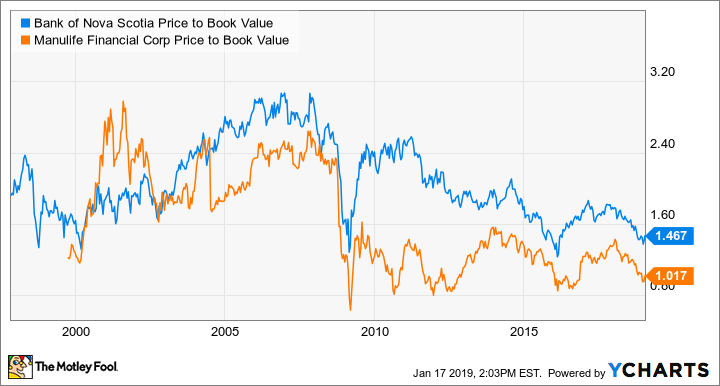2 Cheap Financial Stocks for Income and Dividend Growth

Manulife Financial (TSX:MFC)(NYSE:MFC) and Bank of Nova Scotia (TSX:BNS)(NYSE:BNS) can deliver long-term annualized total returns of more than 10% from current levels. If investors perform active trading, particularly in Manulife, they can achieve higher returns.

Manulife is hugely discounted
Manulife is a bargain stock. At about $21 per share, it trades at a price-to-earnings multiple (P/E) of about 7.6, while it normally trades at a P/E of about 12.7. This multiple indicates a fair-value estimate of almost $35 per share. In other words, Manulife is undervalued by about 40%.
The analyst consensus is optimistic about Manulife, too. It estimates that the insurance company will increase its earnings per share (EPS) at a compound annual growth rate (CAGR) of 14-15.3% over the next three to five years. So, Manulife is, at worst, trading at a cheap PEG ratio of 0.55.
Thomson Reuters has a 12-month mean target of $28.70 per share and a high target of $35.20 per share on Manulife. In one year’s time, there’s a greater chance that the stock will reach the $28 level. It’s more reasonable to target the $35 level for an investment of more than two years.
One reason Manulife is trading at a huge discount is because the company is in a lawsuit. However, the business has been chugging along and increasing its dividend. Its three-year dividend-growth rate is 13.7%. In other words, it increased its quarterly dividend by 47% from three years ago.
BNS Price to Book Value data by YCharts. The price to book histories of Scotiabank and Manulife indicate the stocks are on the cheap side.
Bank of Nova Scotia
Bank of Nova Scotia is discounted. At about $73 per share, it trades at a P/E of about 10.2, while it normally trades at a P/E of about 11.9. This multiple indicates a fair-value estimate of about $86 per share. In other words, the bank is undervalued by about 15%.
The analyst consensus thinks the international bank will continue to grow with stable EPS increases of about 5-8% per year on average over the next three to five years. Reuters has a 12-month mean target of $84.10 per share, which represents about 15% near-term upside potential.
Bank of Nova Scotia makes tonnes of money. In fiscal 2018, it reported net income of $8.7 billion. On a per-share basis, its earnings increased at a CAGR of about 7.5% over three years’ time. Over the same period, it increased its dividend per share at a CAGR of 6.4%. Going forward, investors can expect the bank to increase its dividend by about 6% per year.
Investor takeaway
Patient investors should be rewarded with capital gains from Manulife and Bank of Nova Scotia. In the meantime, collect safe dividends with yields of about 4.6% from both stocks.
More reading
Tax-Free Fortune: 2 Stocks to Pay You $5,000 a Year With a $50,000 TFSA
Will Aurora Cannabis Inc. (TSX:ACB) Stock Hit Double Digits This Winter?
Fool contributor Kay Ng owns shares of MANULIFE FIN and The Bank of Nova Scotia.

 Yahoo Finance
Yahoo Finance 
